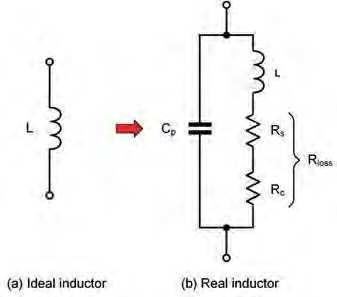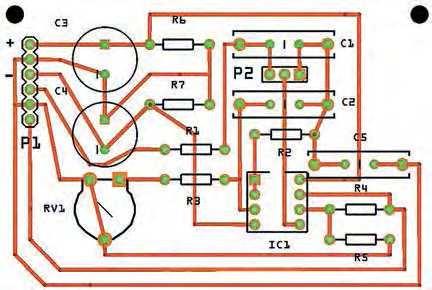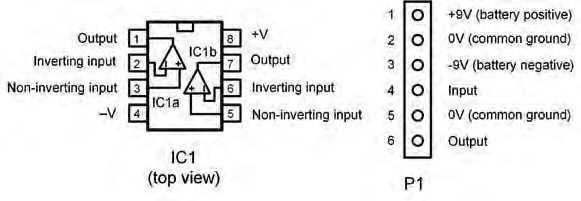
10 minute read
ic tart by Mike Tooley
KickStart
by Mike Tool ey
Advertisement
Part 3: Making sense of inductors
Our occasional KickStart series aims to show readers how to use readily available low-cost components and devices to solve a wide range of common problems in the shortest possible time. Each of the examples and projects can be completed in no more than a couple of hours using off-the-shelf parts. As well as briefly explaining the underlying principles and technology used, the series will provide you with a variety of representative solutions and examples, along with just enough information to enable you to adapt and extend them for your own use.
This third instalment shows you how to design and realise inductive components in a wide range of electronic applications and, in keeping with the K i c kSta r t philosophy, we’ve provided ideas for you to start making use of inductors in your own projects.
frequency-selective circuits. Inductors are also used in noise and interference suppression applications across a wide range of frequencies, from mains (50/60Hz) to RF.
The most basic form of air-cored inductor is nothing more than a coil of insulated wire wound on a non-conductive former. Larger values of inductor can benefit from the enhanced magnetic properties offered by a core made from a ferromagnetic material such as steel (often laminated) or ferrite (a ceramiclike material with magnetic properties).
Inductors are widely available in a range of off-the-shelf values and ratings, but they can also be made at home relatively easily, though this can sometimes be a hit and miss process. Before we explain this, take a look a typical selection of the small inductors that you might encounter in electronics, as shown in Fig.3.1 and Table 3.1.
When is an inductor not an inductor?
Fig.3.1. A typical selection of small inductors. Unfortunately, compared with resistors or even capacitors, inductors rarely behave perfectly, and this can be an important
What are inductors? They are components that factor in their design and application. Fig.3.2 shows an store energy in the form of an electromagnetic field, ‘ideal’ inductor together with its real-world equivalent which and like resistors and capacitors, they are classified incorporates the losses and stray reactance found in ‘real’ as passive devices. When a changing or alternating current is components. The essential features shown in Fig.3.2(b) include: applied to an inductor it will respond by temporarily storing L The inductance value, determined by the number of turns energy in an electromagnetic field, releasing it back at some and magnetic properties of the core material. later time. This temporary storage of energy has the effect of Cp The distributed capacitance (ie, the lumped-together slowing the change in current that causes it. capacitance between adjacent turns, connecting wires
When an alternating current (eg, a sinewave) is applied to an and/or terminals). This capacitance can be problematic inductor the effect of the inductor (in terms of opposition to at high frequencies where the capacitive reactance may current flow) is referred to as ‘inductive reactance’. The faster fall to a relatively low value. the current changes, the greater will be the reactance, and vice versa. Hence inductive Table 3.1 Brief details of the inductors shown in Fig. 3.1 reactance is directly proportional to the Ref. Inductance Notes frequency of the applied current. Like resistance (which strictly applies to steady A 3.5mH Adjustable ferrite inductor for PCB mounting direct current) reactance is measured in ohms ( ) and is defined simply as the ratio B 2.8mH Choke for use in low-frequency radio applications of applied alternating voltage to the current C 1mH Small ferrite pot-cored inductor for general-purpose applications flowing. A 100mH inductor will exhibit a reactance of approximately 63 at 100Hz, D 100µH Large ferrite pot-cored inductor for high-current applications 630 at 10kHz, and 6.3k at 100kHz. E 100µH Fixed toroidal inductor for use in filters
Inductors are used in power supplies F 33µH Wire-ended axial-lead choke for RF applicationsto filter alternating current from direct current, in which case they are sometimes G 3.9µH Small axial-lead inductor for general-purpose applications referred to as ‘chokes’ or ‘reactors’. In audio H 2µH Adjustable ferrite-cored inductor for use in RF tuned circuits and communication systems inductors are often employed in filters and other I 300nH Air-cored inductor for use in VHF and UHF radio applications

Fig.3.2. ‘Ideal’ and ‘real’ inductors. Rloss The total loss resistance of the inductor. This is the sum of its copper winding loss resistance (Rs) and the core loss resistance (Rc). Rs The copper winding loss resistance which can be measured between the terminals of an inductor using an ohmmeter Rc The core resistance is attributable t o t h e c o n t i n u o u s p r o c e s s o f magnetising and demagnetising the core during each cycle of the applied alternating current. Note that, in the case of large inductors Rc can be significantly greater than Rs.
Quality factor
The quality factor (Q) of an inductor is simply the ratio of its effective reactance to its loss resistance; it can thus be taken as an indicator of how Part 3: Making sense of inductors ‘good’ a component it is. Q-factor can be calculated from: Q-factor is important in many applications and it might be worth illustrating this with an example. Let’s assume that we L have two inductors with the properties shown in Table 3.2. The Q-factor for each component has been calculated for a working frequency of 10kHz – note the large reduction in quality factor due to the relatively imperfect core material used in the manufacture of component B.
Q
XL 2p fL = =
loss s c + R R R L = n2AL
We have chosen an off-the-shelf toroidal core manufactured by TDK using N30 Part 3: Making sense of inductors SIFFERIT material. Referring to the manufacturer’s data, the core has a quoted Q permeability (µ) of 4300 and a resulting specific inductance (AL) of 5460 (in nH). Rearranging the formula that we met loss s 2 c LX fL R R R p Part 3: Making sense of inductors earlier allows us to calculate the number of turns required, as follows: 2LX fLQ pPart 3: Making sense of inductors 2 Where AL is the specific inductance quoted in in nanohenries (1nH = 10-9H). We will put this formula to good use in L loss s c pX fLQ R R R L L n = A loss s c R R R the next section. Manufacturing toroidal inductors L Fortunately, inductors with values n = A Where L is the required value of inductance (in henry) and AL is the value of specific inductance (5460 in the case of the N30 core). Hence the number of 3 9 1.1 10 1100 n = = = 201.5 14 turns 5460 10 5.46 ´ » ´ L L n = ranging from about 10µH to 100mH, LA turns required is given by: can be very easily manufactured using stock ferrite toroidal cores. However, when purchasing a suitable core, you n = 3 9 1.1 10 1100 = = 201.5 14 turns 5460 10 5.46 ´ » ´ may need to consider several properties, including the following: Core material and its magnetic 3 9 1.1 10 1100 n = = = 201.5 14 turns 5460 10 5.46 ´ » ´ characteristics The core measures 35.5 × 13.6mm and Physical dimensions of the core will easily accommodate the number ( n o t a b l y e x t e r n a l a n d i n t e r n a l of turns required. To safely carry the diameter and thickness) required current and minimise copper Required current handling capacity winding losses, the wire will need to and maximum allowable winding r e s i s t a n c e ( t h e s e w i l l i n t u r n determine the required wire gauge) Number of turns required for a specified value of inductance (note that the physical dimensions will limit the maximum number of turns that can be used). The design process is best illustrated by taking a simple example. Let’s suppose that we need an inductor with the following specifications for use in a highcurrent switched-mode power supply:
Inductance 1.1mH n = Current-handling capacity 5A
AL Operating frequency 300kHz Maximum winding resistance 0.2 n = 3 9 1.1 10 1100 = = 201.5 14 turns 5460 10 5.46 ´ » ´
Fig.3.3. Author’s 1.1mH toroidal inductor.

Inductance
The value of inductance (L) is determined by the specific inductance of the core, AL. This, in turn, is determined by the effective permeability (µe) of the core material, its physical dimensions and construction. Specific inductance is usually quoted in nH and can be found from the core manufacturers’ published data. The value of inductance can be calculated using the relationship:
Table 3.2 Comparison of two inductors

Inductor A Inductor B 1
L = 100mH L = 100mH
Cp = 11pF
Cp = 18pF Rs = 1Ω Rs = 5Ω Rc = 29Ω Rc = 95Ω Q = 209 Q = 63

be of appropriate gauge and diameter. The chosen diameter (1.5mm) of enamelled copper wire has a quoted resistance of less than 0.01 /m and thus the voltage drop resulting from a continuous direct current of 5A and a total winding length of 500mm should be less than 25mV. See the Going further section for further information on selecting suitable wire.
The value of inductance can be checked using a test meter with an inductance range or by using a network analyser or an AC bridge. Alternatively, a low-cost component tester like the one in Fig.3.4 can be used to provide an indication sufficient to confirm that the required value of inductance has been achieved. A tolerance of up to about ±10% is usually quite acceptable for most applications, but it is always wise to check the calibration of a test instrument using a known Fig.3.5. A gyrator-based equivalent inductor – note that in both circuits component before attempting to make a measurement. R1 >> R2, and R1 is grounded. Thanks to the high gain and negative
At this point, a few notes of caution would feedback of the op amp, the effective impedance looking into the R2/C not go amiss. First, the permeability of ferrite terminal is: R2 + L, where L = R1 × R2 × C. and other ferromagnetic alloy materials tends to fall very sharply at high temperatures (ie, above about 125°C). Beyond this point a material’s magnetic properties can collapse very quickly. Second, it is not unusual for cores to heat up during operation, particularly when high flux densities are present, along with high-frequency current. This can further exacerbate the reduction in permeability, and it c a n s e v e r e l y l i m i t t h e performance of a core. In Fig.3.6. Circuit of the gyrator-based bandpass audio filter.


Fig.3.7. PCB track layout for the gyrator-based bandpass audio filter.
KS3-2021 Fig.3.9. Pin connections for the gyrator-based bandpass audio filter.


all cases it is worth referring to manufacturers’ data, checking both the permeability characteristics and recommended frequency range.
Simulating inductors
Unfortunately, it can sometimes be difficult to manufacture the relatively large-value inductors needed for use in audio and low-frequency applications. However, there’s a potential solution in the form of a circuit that can simulate an inductor using just capacitors and resistors, together with an active device such as a transistor or operational amplifier. This arrangement is called a ‘gyrator’, and it works by acting like a mirror which effectively reflects an equal but opposite reactance to that present at its input. The circuit of a gyrator-based equivalent inductor is shown in Fig.3.5. Note that, in common with most gyrator circuits, this arrangement expects to be fed from a ground-referenced (0V) low-impedance source.
A bandpass audio filter based on a gyrator
To put this into context let’s take a look at a practical application for a gyrator in the form of a tuneable bandpass audio filter where the gyrator







